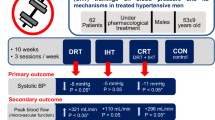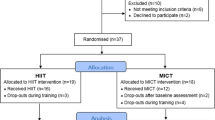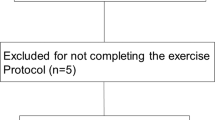Abstract
The aims of the present study were to analyze the effects of 16 weeks of different aerobic exercise training (ExT) programs with diet on cardiac autonomic modulation and hemodynamics in nonphysically active and overweight/obese adults (n = 249, 53.7 ± 8.0 years) with primary hypertension, and the possible differences among ExT programs and their effects on heart rate (HR), blood pressure (BP), and long-term BP variability (BPV). Participants were randomly assigned into an attention control (AC) group (physical activity recommendations) or one of three supervised ExT groups: high volume of moderate-intensity continuous training, high-volume and high-intensity interval training (HIIT), and low-volume-HIIT. Twenty-four hours of ambulatory BP monitoring was used to analyze systolic (SBP) and diastolic (DBP) BP, HR, and BPV. A cardiopulmonary exercise test was performed to determine peak oxygen uptake (VO2peak). Following intervention, resting and submaximal exercise (HR, SBP, and DBP), along with diurnal and nocturnal SBP and DBP values decreased (P < 0.05) in all groups with no differences between groups. When the ExT groups were combined, submaximal SBP (P = 0.048) and DBP (P = 0.004), VO2peak (P = 0.014) and HR reserve (P = 0.030) were significantly improved compared with AC. Intervention did not have significant effects on BPV. In the present study better improvements in the autonomic nervous system were seen when the aerobic ExT was individually designed and supervised with pari passu effects irrespective of exercise intensity and volume. Low-volume-HIIT ExT combined with a healthy diet should be considered as a time efficient and safe mechanism for reducing the cardiovascular risk in hypertensive individuals.
This is a preview of subscription content, access via your institution
Access options
Subscribe to this journal
Receive 12 digital issues and online access to articles
$119.00 per year
only $9.92 per issue
Buy this article
- Purchase on Springer Link
- Instant access to full article PDF
Prices may be subject to local taxes which are calculated during checkout

Similar content being viewed by others
References
Mancia G, Grassi G. The autonomic nervous system and hypertension. Circ Res. 2014;114:1804–14.
Mitchell JH. Abnormal cardiovascular response to exercise in hypertension: contribution of neural factors. Am J Physiol-Regulatory, Integr Comp Physiol. 2017;312:R851–63.
Schillaci G, Bilo G, Pucci G, Laurent S, Macquin-Mavier I, Boutouyrie P, et al. Relationship between short-term blood pressure variability and large-artery stiffness in human hypertension: findings from 2 large databases. Hypertension. 2012;60:369–77.
Mancia G. Short-and long-term blood pressure variability: present and future. Hypertension. 2012;60:512–7.
Mancia G, Fagard R, Narkiewicz K, Redon J, Zanchetti A, Bohm M, et al. 2013 ESH/ESC Guidelines for the management of arterial hypertension: the Task Force for the management of arterial hypertension of the European Society of Hypertension (ESH) and of the European Society of Cardiology (ESC). J Hypertens. 2013;31:1281–357.
Halliwill JR, Buck TM, Lacewell AN, Romero SA. Postexercise hypotension and sustained postexercise vasodilatation: what happens after we exercise? Exp Physiol. 2013;98:7–18.
Caminiti G, Mancuso A, Raposo AF, Fossati C, Selli S, Volterrani M. Different exercise modalities exert opposite acute effects on short-term blood pressure variability in male patients with hypertension. Eur J Preventive Cardiol. 2019;26:1028–31. 2047487318819529.
Cuspidi C, Tadic M, Grassi G, Mancia G. Treatment of hypertension: the ESH/ESC guidelines recommendations. Pharm Res. 2018;128:315–21.
Whelton PK, Carey RM, Aronow WS, Casey DE, Collins KJ, Himmelfarb CD, et al. 2017 ACC/AHA/AAPA/ABC/ACPM/AGS/APhA/ASH/ASPC/NMA/PCNA guideline for the prevention, detection, evaluation, and management of high blood pressure in adults: a report of the American College of Cardiology/American Heart Association Task Force on Clinical Practice Guidelines. J Am Coll Cardiol. 2018;71:e127–248.
Anunciação PG, Polito MD. A review on post-exercise hypotension in hypertensive individuals. Arq Bras Cardiol. 2011;96:425–6.
Cardoso CG Jr, Gomides RS, Queiroz AC, Pinto LG, da Silveira Lobo F, Tinucci T, et al. Acute and chronic effects of aerobic and resistance exercise on ambulatory blood pressure. Clinics. 2010;65:317–25.
Edwards KM, Wilson KL, Sadja J, Ziegler MG, Mills PJ. Effects on blood pressure and autonomic nervous system function of a 12‐week exercise or exercise plus DASH‐diet intervention in individuals with elevated blood pressure. Acta Physiologica. 2011;203:343–50.
Pagonas N, Dimeo F, Bauer F, Seibert F, Kiziler F, Zidek W, et al. The impact of aerobic exercise on blood pressure variability. J Hum Hypertens. 2014;28:367–71.
Gorostegi-Anduaga I, Corres P, MartinezAguirre-Betolaza A, Perez-Asenjo J, Aispuru GR, Fryer SM, et al. Effects of different aerobic exercise programmes with nutritional intervention in sedentary adults with overweight/obesity and hypertension: EXERDIET-HTA study. Eur J Prev Cardiol. 2018;25:343–53.
Maldonado-Martín S, Gorostegi-Anduaga I, Aispuru G, Illera-Villas M, Jurio-Iriarte B. Effects of different aerobic exercise programs with nutritional intervention in primary hypertensive and overweight/obese adults: EXERDIET-HTA controlled trial. J Clin Trials. 2016;6:2167–0870.1000252.
Parati G, Ochoa JE, Lombardi C, Bilo G. Assessment and management of blood-pressure variability. Nat Rev Cardiol. 2013;10:143–55.
Mezzani A, Hamm LF, Jones AM, McBride PE, Moholdt T, Stone JA, et al. Aerobic exercise intensity assessment and prescription in cardiac rehabilitation: a joint position statement of the European Association for Cardiovascular Prevention and Rehabilitation, the American Association of Cardiovascular and Pulmonary Rehabilitation and the Canadian Association of Cardiac Rehabilitation. Eur J Prev Cardiol. 2013;20:442–67.
Huxley R, Mendis S, Zheleznyakov E, Reddy S, Chan J. Body mass index, waist circumference and waist:hip ratio as predictors of cardiovascular risk—a review of the literature. Eur J Clin Nutr. 2010;64:16–22.
Kaminsky LA, Imboden MT, Arena R, Myers J. Reference standards for cardiorespiratory fitness measured with cardiopulmonary exercise testing using cycle ergometry: Data From the Fitness Registry and the Importance of Exercise National Database (FRIEND) Registry. Mayo Clin Proc. 2017;92, 228-33.
Prasad VK, Hand GA, Sui X, Shrestha D, Lee DC, Lavie CJ, et al. Association of exercise heart rate response and incidence of hypertension in men. Mayo Clin Proc. 2014;89:1101–7.
Carnagarin R, Gregory C, Azzam O, Hillis GS, Schultz C, Watts GF, et al. The role of sympatho-inhibition in combination treatment of obesity-related hypertension. Curr Hypertens Rep. 2017;19:99.
Pimenta FC, Montrezol FT, Dourado VZ, da Silva LFM, Borba GA, de Oliveira Vieira W, et al. High-intensity interval exercise promotes post-exercise hypotension of greater magnitude compared to moderate-intensity continuous exercise. Eur J Appl Physiol. 2019;119:1235–43.
Nicoll R, Henein M. Caloric restriction and its effect on blood pressure, heart rate variability and arterial stiffness and dilatation: a review of the evidence. Int J Mol Sci. 2018;19:751.
Blumenthal JA, Babyak MA, Hinderliter A, Watkins LL, Craighead L, Lin P, et al. Effects of the DASH diet alone and in combination with exercise and weight loss on blood pressure and cardiovascular biomarkers in men and women with high blood pressure: the ENCORE study. Arch Intern Med. 2010;170:126–35.
Molmen-Hansen HE, Stolen T, Tjonna AE, Aamot IL, Ekeberg IS, Tyldum GA, et al. Aerobic interval training reduces blood pressure and improves myocardial function in hypertensive patients. Eur J Prev Cardiol. 2012;19:151–60.
Kokkinos P, Pittaras A, Narayan P, Faselis C, Singh S, Manolis A. Exercise capacity and blood pressure associations with left ventricular mass in prehypertensive individuals. Hypertension. 2007;49:55–61.
Nystoriak MA, Bhatnagar A. Cardiovascular effects and benefits of exercise. Front Cardiovasc Med. 2018;5:135.
Marrone O, Bonsignore MR. Blood-pressure variability in patients with obstructive sleep apnea: current perspectives. Nat Sci Sleep. 2018;10:229–42.
Kikuya M, Ohkubo T, Metoki H, Asayama K, Hara A, Obara T, et al. Day-by-day variability of blood pressure and heart rate at home as a novel predictor of prognosis: the Ohasama study. Hypertension. 2008;52:1045–50.
Asayama K, Schutte R, Li Y, Hansen TW, Staessen JA. Blood pressure variability in risk stratification: What does it add? Clin Exp Pharmacol Physiol. 2014;41:1–8.
Castrillón CIM, Miranda RAT, Cabral-Santos C, Vanzella LM, Rodrigues B, Vanderlei LCM, et al. High-intensity intermittent exercise and autonomic modulation: effects of different volume sessions. Int J Sports Med. 2017;38:468–72.
Acknowledgements
Our special thanks to G. Rodrigo Aispuru, the medical doctor who has taken part in this project with medical assessment. Also thanks to the Department of Physical Education and Sport and Faculty of Physical Education and Sport-Physical Activity and Sport Sciences Section (University of the Basque Country, UPV/EHU) for believing in our project and providing the material and facilities to carry it out. Also thanks to Exercycle S.L. (BH Fitness Company) for the machines donated to conduct the exercise intervention. Last but not least to all undergraduate and postgraduate students who collaborated in this project (2011–2017 academic years).
Funding
This work was supported by the University of the Basque Country (EHU14/08, PPGA18/15) and the Government of the Basque Country supported PC, AMAB, and IGA with predoctoral grants.
Author information
Authors and Affiliations
Corresponding author
Ethics declarations
Conflict of interest
The authors declare that they have no conflict of interest.
Additional information
Publisher’s note Springer Nature remains neutral with regard to jurisdictional claims in published maps and institutional affiliations.
Rights and permissions
About this article
Cite this article
MartinezAguirre-Betolaza, A., Mujika, I., Fryer, S.M. et al. Effects of different aerobic exercise programs on cardiac autonomic modulation and hemodynamics in hypertension: data from EXERDIET-HTA randomized trial. J Hum Hypertens 34, 709–718 (2020). https://doi.org/10.1038/s41371-020-0298-4
Received:
Revised:
Accepted:
Published:
Issue Date:
DOI: https://doi.org/10.1038/s41371-020-0298-4



